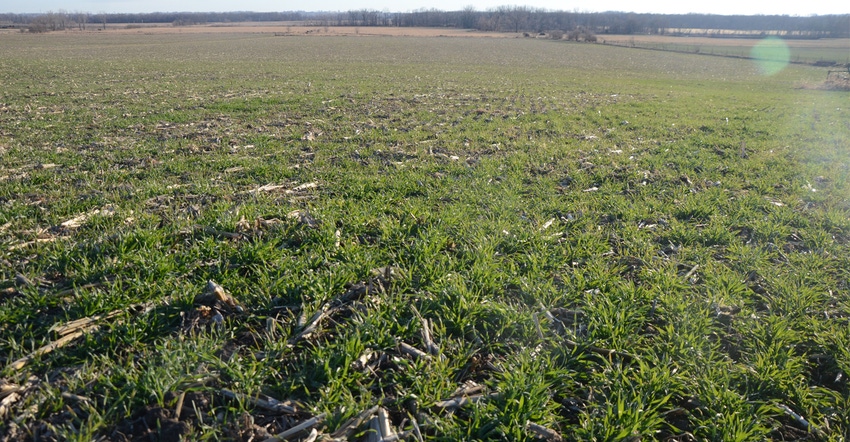
Throughout his childhood, Wade Dooley has dealt with flooding every year on his farm along the Iowa River in Marshall County, Iowa. Most of the time, the damage wasn’t extensive — the late 1990s and early 2000s, when floods began getting bigger and more frequent.
“In ’97, it was almost a total loss of everything along the river,” Dooley says. “That’s what got us started doing cereal rye for cover crops on our farm. We lost enough acres that we chopped what was left and put cereal rye in that area so we had fodder for the cattle.”
Related: Challenges with riverside grazing
For the next 20 years, Dooley and his dad strictly seeded rye after corn silage. However, in 2007, when Dooley came back to the farm after graduating from Iowa State University and a stint in the vegetable seed industry in Florida, they began experimenting more. First, it was successfully broadcasting oats into standing soybeans on a small acreage. Then, it was broadcasting winter wheat with a high-clearance machine in soybeans, followed by aerial seeding into standing soybeans.
“With our river bottom, we’ve used rye for several years. It doesn’t dry the ground out so much on river bottom, but it makes it more solid,” he says. “So we can just plant beans straight into a stand of rye in a swamp. We don’t get mud on the tires. We don’t get mud on the planter. I don’t have to get out with a putty knife and scrape all disk openers off.”
Perennial problems
Perennial flooding can cause a number of issues for cash crops and pasture, including depositing sand and silt, making soil anaerobic, leaving a window for weed seeds to germinate and even introducing new weed seeds. However, cover crops can change river bottom ground for the better.
“If you don’t put any kind of life out there, Mother Nature will, and it’s usually waterhemp,” Dooley says. “You won’t find any waterhemp here. Every year we’ve had cover crops on it for the last couple of years, and there are no more waterhemp problems. They can’t compete with rye because it has a small seed, and the allelopathy from the rye roots just delays waterhemp long enough that it only gets one flush of growth instead of two. Our chemical program then wipes it out after that.”
Cover crops also help improve soil water infiltration, drying out flooded soil and making it easier to plant. In addition, they provide a food source for soil microbial life, which, combined with improved soil water infiltration and organic matter, helps keep soil biologically active.
“One year I had 70 acres completely flood out. It killed everything. We went in and seeded oats and radishes, and late July was the earliest we could get in. That whole field stayed green through to January, February,” Dooley says. “In spring, it winter-killed, and there was nothing left. I panicked, because it was beautiful cover all winter long. I thought we were going to have a great cover in the spring. It had collapsed, and the earthworms and microbes just ate every bit of it.”
“Right next to the river, it was pretty wet that spring. We planted it, and I had the planter set for standard, no till conditions,” he adds. “Especially after a flood, you figure the soil is going to be like concrete. So I had heavy down pressure, and it just buried the planter. I got out of the tractor, and it was like I was walking on a sponge. I had to reset the planter for basically planting into plowed ground, and it was a no till field. I had to set it super light.”
Soybean survival
That year, when the soybeans reached about 18 to 24 inches in height, the river flooded for a week.
“Usually, three days underwater and soybeans are dead. The water receded and all I had was 70 acres of black toothpicks, because all the silt had caked on the stems. I wrote the whole field off as loss,” Dooley says. “Later, I went down to the field, and there were little leaves on every one of those black toothpicks. The whole field regrew.
“It was still a loss, but I combined 25-bushel soybeans in a field that should have been zero. I’m pretty sure it was because I had oats and the radishes there the previous year, and all those earthworms and everything made so many holes there was enough oxygen in the ground to keep the plants alive.”
Read more about:
FloodingAbout the Author(s)
You May Also Like






